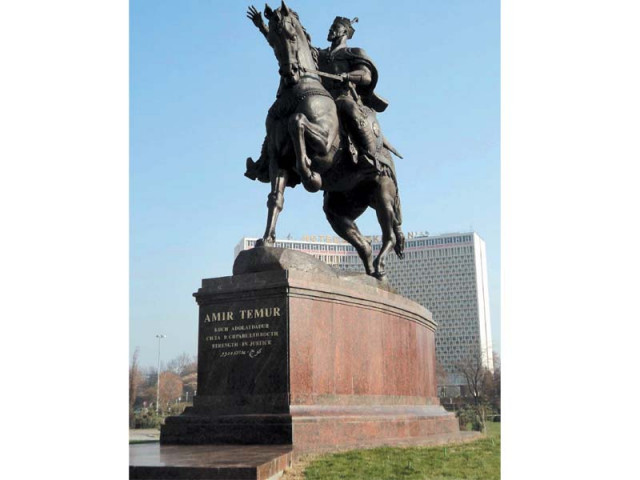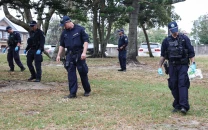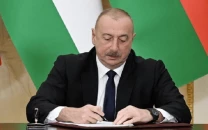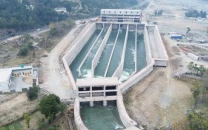The original iron man
Amir Temur is regarded by most Central Asians as a hero and his time is remembered fondly by many Uzbeks.

Sitting atop a horse, with a hand raised towards the sky as though he were the master of all he surveyed, the statue of Amir Temur — whose name means ‘Iron’ in Persian — welcomes all who enter the spacious square in the heart of the Uzbek capital of Tashkent.
At the base of the statue, one spies an inscription: “Strength is in justice,” a quotation attributed to the man regarded as a hero by most Central Asians and despised as a villain by much of the rest of the world.
Amir Temur Square, where the statue is located, has had many changes of name — transforming every time a new regime decided to put its own stamp on history. It was first built in the 1870s, by the Russian Imperial Government, and was known as Konstantin Square. The statue in the middle of the square then was that of General Konstantin Petrovich von Kaufman, a Russian aristocrat and the first governor-general of Russian Turkestan (of which modern Uzbekistan was then a part).
After the Bolshevik Revolution of 1917, the statue was replaced with a Monument of the Free Workers. At the height of Stalin’s reign, that statue was replaced by one of Joseph Stalin himself. In 1968, as the glorification of Stalin was purged from Soviet textbooks, it was replaced by one of Karl Marx. Finally, in the early 1990s, as the Central Asian Republics gained independence, it was renamed Amir Temur Square.
Amir Temur is regarded by most Central Asians as a hero and his time is remembered fondly by many Uzbeks. “Temur has a revered place in our hearts. He was a true leader, a real amir who helped develop the whole region with art, architecture, literature, science and trade,” said Aziz Mirza, a resident of Samarkand.
That’s understandable, because despite the depredations and massacres Temur carried out in other lands, he was very particular in his desire to make Samarkand the greatest city in the world. This city of blue domes still bears Temur’s architectural imprint.
“He was a real talent seeker and used to bring the most gifted artisans to Samarkand from the areas which he conquered. He would leave them (artisans) free to express themselves in their respective arts and that’s why one can see grandeur in the architecture of his time,” Mirza added.
The design of the museum itself, with its distinctive blue rotunda visible from afar, also harkens to the Timurid era. The main gallery, circular in shape, has several large paintings of Amir Temur and other kings of the Temurid dynasty. It also has a very large copy of the Quran, which is labelled “Usman’s Quran, 7th century”.
Perhaps what is extraordinary about the museum is that much of its displays are replicas of Temurid artefacts, manuscripts and artwork, as the originals are on display in other museums around the world. Yet the museum nonetheless manages to paint the Temurid era as a golden age, with no references anywhere to be found of the dynasty’s fabled brutality. The whitewashing of history it seems is not limited to the square itself. Not that it bothers the visitors.
“The period of Temur and Temurids shines in the pages of Uzbekistan’s history. Some even refer to it as the ‘Temurids Renaissance’,” said Ajmal, a Tashkent University student who was visiting the museum.
“I really feel honour and pride in our heritage which makes me realise that our ancestors contributed much to human civilisation,” said Yasmeen, another student and resident of Tashkent.
Some of the displays are indeed of people who made impressive contributions to local culture. There is, for example, a miniature of the great Uzbek poet Alisher Navoi in the literature gallery. Close to the miniature is an inscription with a quotation of another famous Central Asian warrior, one more familiar to Pakistanis: Zaheeruddin Babar. “Nobody wrote more and better than Alisher Navoi since the very first lines in the Turkic languages had been written,” the first Mughal emperor was quoted as having said.
Other displays include quotes from Amir Temur himself. “I befriended travellers from each country and province and they entrusted me with information from their lords. And I appointed merchants and caravanserai to travel to each country including China, Khotan, India, Rum, Algeria, France and Egypt from which they brought skills and gifts,” says one such inscription.
Another gallery portrays Temur as a builder of mosques and schools and included another quote from the Amir himself: “In every city, town and village, I established mosques, schools, and guest houses, alms houses for the poor and hospitals for the rich with physicians to treat them. In every city, I established palaces and courts to administer justice fairly.”
The warriors of Central Asia were no doubt more than just marauding hordes and they — including Amir Temur himself — deserve to be remembered for much more than just their bloody conquests. The museum in Tashkent is a valuable lesson in history, because it shows that the warrior-kings of Turkestan did not just destroy their enemies, they also sought to emulate their finest traditions.
Published in The Express Tribune, Sunday Magazine, June 3rd, 2012.



















COMMENTS
Comments are moderated and generally will be posted if they are on-topic and not abusive.
For more information, please see our Comments FAQ